Multimodel Ensemble Projections of Wave Climate in the Western North Pacific Using CMIP6 Marine Surface Winds
Abstract
:1. Introduction
2. Materials and Method
2.1. Datasets
2.2. Wave Modelling
2.3. Wave Model Setups
3. Results
3.1. Wave Validation
3.2. Historical and Future Wave Characteristics
4. Discussion
5. Conclusions
Supplementary Materials
Author Contributions
Funding
Institutional Review Board Statement
Informed Consent Statement
Data Availability Statement
Acknowledgments
Conflicts of Interest
References
- Caldwell, P.C.; Aucan, J.P. An Empirical Method for Estimating Surf Heights from Deepwater Significant Wave Heights and Peak Periods in Coastal Zones with Narrow Shelves, Steep Bottom Slopes, and High Refraction. J. Coast. Res. 2007, 23, 1237–1244. [Google Scholar] [CrossRef] [Green Version]
- Buckley, R.C. Surf Tourism and Sustainable Development in Indo-Pacific Islands. I. The Industry and the Islands. J. Sustain. Tour. 2002, 10, 405–424. [Google Scholar] [CrossRef] [Green Version]
- Chen, C.; Shiotani, S.; Sasa, K. Numerical Ship Navigation Based on Weather and Ocean Simulation. Ocean. Eng. 2013, 69, 44–53. [Google Scholar] [CrossRef] [Green Version]
- Niedzwecki, J.M.; Huston, J.R. Wave Interaction with Tension Leg Platforms. Ocean. Eng. 1992, 19, 21–37. [Google Scholar] [CrossRef]
- Drew, B.; Plummer, A.R.; Sahinkaya, M.N. A Review of Wave Energy Converter Technology. Proc. Inst. Mech. Eng. Part. A J. Power Energy 2016, 223, 887–902. [Google Scholar] [CrossRef] [Green Version]
- Kummu, M.; de Moel, H.; Salvucci, G.; Viviroli, D.; Ward, P.J.; Varis, O. Over the Hills and Further Away from Coast: Global Geospatial Patterns of Human and Environment over the 20th–21st Centuries. Environ. Res. Lett. 2016, 11, 034010. [Google Scholar] [CrossRef]
- Coelho, C.; Silva, R.; Veloso-Gomes, F.; Taveira-Pinto, F. Potential Effects of Climate Change on Northwest Portuguese Coastal Zones. ICES J. Mar. Sci. 2009, 66, 1497–1507. [Google Scholar] [CrossRef] [Green Version]
- Flather, R.A. Storm Surges. In Encyclopedia of Ocean Sciences; Steele, J.H., Ed.; Elsevier: Woods Hole, MA, USA, 2001; Volume 5, pp. 530–540. [Google Scholar] [CrossRef]
- Lotze, H.K.; Coll, M.; Magera, A.M.; Ward-Paige, C.; Airoldi, L. Recovery of Marine Animal Populations and Ecosystems. Trends Ecol. Evol. 2011, 26, 595–605. [Google Scholar] [CrossRef] [Green Version]
- Zhao, D.; Toba, Y.; Suzuki, Y.; Komori, S. Effect of Wind Waves on Air’sea Gas Exchange: Proposal of an Overall CO2 Transfer Velocity Formula as a Function of Breaking-Wave Parameter Effect of Wind Waves on Air-Sea Gas Exchange: Proposal of an Overall CO2 Transfer Velocity Formula as a Function of Breaking-Wave Parameter. Tellus B Chem. Phys. Meteorol. 2003, 55, 478–487. [Google Scholar] [CrossRef] [Green Version]
- Caires, S.; Sterl, A.; Bidlot, J.-R.; Graham, N.; Swail, V. Intercomparison of Different Wind-Wave Reanalyses. J. Clim. 2004, 17, 1893–1913. [Google Scholar] [CrossRef]
- Mori, N.; Shimura, T.; Kamahori, H.; Chawla, A. Historical Wave Climate Hindcasts Based on JRA-55. In Proceedings of the Coastal Dynamics, Helsingør, Denmark, 12–16 June 2017; pp. 117–124. [Google Scholar]
- Chawla, A.; Spindler, D.M.; Tolman, H.L. Validation of a Thirty Year Wave Hindcast Using the Climate Forecast System Reanalysis Winds. Ocean. Model. 2013, 70, 189–206. [Google Scholar] [CrossRef]
- Wen, C.; Kumar, A.; Xue, Y. Uncertainties in Reanalysis Surface Wind Stress and Their Relationship with Observing Systems. Clim. Dyn. 2019, 52, 3061–3078. [Google Scholar] [CrossRef]
- Schweikert, A.; Espinet, X.; Chinowsky, P. The Triple Bottom Line: Bringing a Sustainability Framework to Prioritize Climate Change Investments for Infrastructure Planning. Sustain. Sci. 2018, 13, 377–391. [Google Scholar] [CrossRef]
- Hemer, M.A.; Fan, Y.; Mori, N.; Semedo, A.; Wang, X.L. Projected Changes in Wave Climate from a Multi-Model Ensemble. Nat. Clim. Chang. 2013, 3, 471–476. [Google Scholar] [CrossRef]
- Fan, Y.; Held, I.M.; Lin, S.; Wang, X.L. Ocean Warming Effect on Surface Gravity Wave Climate Change for the End of the Twenty-First Century. J. Clim. 2013, 26, 6046–6066. [Google Scholar] [CrossRef]
- Wang, X.L.; Feng, Y.; Swail, V.R. Changes in Global Ocean Wave Heights as Projected Using Multimodel CMIP5 Simulations. Geophys. Res. Lett. 2014, 41, 1026–1034. [Google Scholar] [CrossRef]
- Bennett, W.G.; Karunarathna, H.; Mori, N.; Reeve, D.E. Climate Change Impacts on Future Wave Climate around the UK. J. Mar. Sci. Eng. 2016, 4, 78. [Google Scholar] [CrossRef] [Green Version]
- Shimura, T.; Mori, N.; Mase, H. Future Projection of Ocean Wave Climate: Analysis of SST Impacts on Wave Climate Changes in the Western North Pacific. J. Clim. 2015, 28, 3171–3190. [Google Scholar] [CrossRef] [Green Version]
- Meehl, G.A.; Covey, C.; Delworth, T.; Latif, M.; McAvaney, B.; Mitchell, J.F.B.; Stouffer, R.J.; Taylor, K.E. The WCRP CMIP3 Multimodel Dataset: A New Era in Climatic Change Research. Bull. Am. Meteorol. Soc. 2007, 88, 1383–1394. [Google Scholar] [CrossRef] [Green Version]
- Asariotis, R.; Benamara, H.; Premti, A.; Lavelle, J. Maritime Piracy: An. Overview of Trends, Costs and Trade-Related Implications, 1st ed.; United Nations Conference on Trade and Development: Geneva, Switzerland, 2014. [Google Scholar]
- Hemer, M.; Katzfey, J.; Hotan, C. The Wind-Wave Climate of the Pacific Ocean.; The Centre for Australian Weather and Climate Research: Melbourne, Australia, 2011; Available online: http://wacop.gsd.spc.int/Atlas/ClimateC/Docs/Report_2011.pdf (accessed on 29 June 2019).
- Hsu, P.-C.; Chu, P.-S.; Murakami, H.; Zhao, X. An Abrupt Decrease in the Late-Season Typhoon Activity over the Western North Pacific. J. Clim. 2014, 27, 4296–4312. [Google Scholar] [CrossRef]
- Murakami, H.; Kitoh, A. Future Change of Western North Pacific Typhoons: Projections by a 20-Km-Mesh Global Atmospheric Model*. J. Clim. 2010, 24, 1154–1169. [Google Scholar] [CrossRef] [Green Version]
- Eyring, V.; Bony, S.; Meehl, G.A.; Senior, C.A.; Stevens, B.; Stouffer, R.J.; Taylor, K.E. Overview of the Coupled Model Intercomparison Project Phase 6 (CMIP6) Experimental Design and Organization. Geosci. Model. Dev. 2016, 9, 1937–1958. [Google Scholar] [CrossRef] [Green Version]
- Church, J.A.; Clark, P.U.; Cazenave, A.; Gregory, J.M.; Jevrejeva, S.; Levermann, A.; Merrifield, M.A.; Milne, G.A.; Nerem, R.S.; Nunn, P.D.; et al. Sea Level Change. In Climate Change 2013: The Physical Science Basis. Contribution of Working Group I to the Fifth Assessment Report of the Intergovernmental Panel on Climate Change; Stocker, T.F., Qin, D., Plattner, G.-K., Tignor, M., Allen, S.K., Boschung, J., Nauels, A., Xia, Y., Bex, V., Midgley, P.M., Eds.; Cambridge University Press: Cambridge, UK; New York, NY, USA, 2013; pp. 1137–1216. [Google Scholar]
- Hersbach, H.; Bell, B.; Berrisford, P.; Hirahara, S.; Horányi, A.; Muñoz-Sabater, J.; Nicolas, J.; Peubey, C.; Radu, R.; Schepers, D.; et al. The ERA5 global reanalysis. Q. J. R. Meteorol. Soc. 2020, 146, 1999–2049. [Google Scholar] [CrossRef]
- Taylor, K.E.; Stouffer, R.J.; Meehl, G.A. An Overview of CMIP5 and the Experiment Design. Bull. Am. Meteorol. Soc. 2012, 93, 485–498. [Google Scholar] [CrossRef] [Green Version]
- Badriana, M.R.; Lee, H.S. Statistical Evaluation of Monthly Marine Surface Winds of CMIP6 GCMs in the Western North Pacific. J. Japan Soc. Civ. Eng. Ser. B2 (Coastal Eng.) 2019, 75, 1219–1224. [Google Scholar] [CrossRef]
- Taylor, K.; Doutriaux, C. CMIP5 Model Output Requirements: File Contents and Format, Data Structure and Metadata, 2010. Infrastructure for the European Network for Earth System Modelling. Available online: https://pcmdi.llnl.gov/mips/cmip5/CMIP5_output_metadata_requirements.pdf (accessed on 2 March 2020).
- O’Neill, B.C.; Tebaldi, C.; Van Vuuren, D.P.; Eyring, V.; Friedlingstein, P.; Hurtt, G.; Knutti, R.; Kriegler, E.; Lamarque, J.F.; Lowe, J.; et al. The Scenario Model Intercomparison Project (ScenarioMIP) for CMIP6. Geosci. Model. Dev. 2016, 9, 3461–3482. [Google Scholar] [CrossRef] [Green Version]
- Tozer, B.; Sandwell, D.T.; Smith, W.H.F.; Olson, C.; Beale, J.R.; Wessel, P. Global Bathymetry and Topography at 15 Arc Sec: SRTM15+. Earth Sp. Sci. 2019, 6, 1847–1864. [Google Scholar] [CrossRef]
- Book, I.I.G.C.; Contributors, O.D. GEBCO_2020 Grid. Available online: https://www.gebco.net/data_and_products/gridded_bathymetry_data/gebco_2020/ (accessed on 11 June 2021).
- Wessel, P.; Smith, W.H.F. A Global, Self-Consistent, Hierarchical, High-Resolution Shoreline Database. J. Geophys. Res. 1996, 101, 8741–8743. [Google Scholar] [CrossRef] [Green Version]
- Tolman, H.L. The Numerical Model. WAVEWATCH; Technical Report for Delft University of Technology: Delft, The Netherlands, 1989. [Google Scholar]
- Tolman, H.L. User Manual and System Documentation of WAVEWATCH III TM Version 3.14; NOAA/NWS/NCEP: Camp Springs, MD, USA, 2009. [Google Scholar]
- Lee, H.S. Evaluation of WAVEWATCH III performance with wind input and dissipation source terms using wave buoy measurements for October 2006 along the east Korean coast in the East Sea. Ocean. Eng. 2015, 100, 67–82. [Google Scholar] [CrossRef]
- Hasselmann, S.; Hasselmann, K. Computations and Parameterizations of the Nonlinear Energy Transfer in a Gravity-Wave Spectrum. Part I: A New Method for Efficient Computations of the Exact Nonlinear Transfer Integral. J. Phys. Oceanogr. 1985, 15, 1369–1377. [Google Scholar] [CrossRef] [Green Version]
- The WAVEWATCH III®Development Group. User Manual and System Documentation of WAVEWATCH III® Version5.16; NOAA/NWS/NCEP/MMAB: College Park, MD, USA, 2016. [Google Scholar]
- Cavaleri, L.; Rizzoli, P.M. Wind Wave Prediction in Shallow Water: Theory and Applications. J. Geophys. Res. 1981, 86, 10961–10973. [Google Scholar] [CrossRef]
- Tolman, H.L. Wind Waves and Moveable-Bed Bottom Friction. J. Phys. Oceanogr. 1994, 24, 994–1009. [Google Scholar] [CrossRef]
- Ardhuin, F.; O’Reilly, W.C.; Herbers, T.H.C.; Jessen, P.F. Swell Transformation across the Continental Shelf. Part I: Attenuation and Directional Broadening. J. Phys. Oceanogr. 2003, 33, 1921–1939. [Google Scholar] [CrossRef]
- Battjes, J.A.; Janssen, J.P.F.M. Energy Loss and Set-Up Due to Breaking of Random Waves. In Proceedings of the Coastal Engineering Conference ASCE, Hamburg, Germany, 29 January 1978; Volume 1, pp. 569–587. [Google Scholar] [CrossRef] [Green Version]
- Ardhuin, F.; Rogers, E.; Babanin, A.V.; Filipot, J.-F.; Magne, R.; Roland, A.; van der Westhuysen, A.; Queffeulou, P.; Lefevre, J.-M.; Aouf, L.; et al. Semiempirical Dissipation Source Functions for Ocean Waves. Part I: Definition, Calibration, and Validation. J. Phys. Oceanogr. 2010, 40, 1917–1941. [Google Scholar] [CrossRef] [Green Version]
- Tolman, H.L. Alleviating the Garden Sprinkler Effect in Wind Wave Models. Ocean. Model. 2002, 4, 269–289. [Google Scholar] [CrossRef]
- Shimura, T.; Mori, N.; Hemer, M.A. Variability and Future Decreases in Winter Wave Heights in the Western North Pacific. Geophys. Res. Lett. 2016, 43, 2716–2722. [Google Scholar] [CrossRef] [Green Version]
- Timmermans, B.; Stone, D.; Wehner, M.; Krishnan, H. Impact of tropical cyclones on modeled extreme wind-wave climate. Geophys. Res. Lett. 2017, 44, 1393–1401. [Google Scholar] [CrossRef]
- Morim, J.; Trenham, C.; Hemer, M.; Wang, X.L.; Mori, N.; Casas-Prat, M.; Semedo, A.; Shimura, T.; Timmermans, B.; Camus, P.; et al. A global ensemble of ocean wave climate projections from CMIP5-driven models. Sci. Data 2020, 7, 1–10. [Google Scholar] [CrossRef]
- IPCC. Summary for Policymakers. In Climate Change 2013: The Physical Science Basis. Contribution of Working Group I to the Fifth Assessment Report of the Intergovernmental Panel on Climate Change; Stocker, T.F., Qin, D., Plattner, G.-K., Tignor, M., Allen, S.K., Boschung, J., Nauels, A., Xia, Y., Bex, V., Midgley, P.M., Eds.; Cambridge University Press: Cambridge, UK; New York, NY, USA, 2013; pp. 3–29. [Google Scholar]
- Riahi, K.; van Vuuren, D.P.; Kriegler, E.; Edmonds, J.; O’Neill, B.C.; Fujimori, S.; Bauer, N.; Calvin, K.; Dellink, R.; Fricko, O.; et al. The Shared Socioeconomic Pathways and Their Energy, Land Use, and Greenhouse Gas Emissions Implications: An Overview. Glob. Environ. Chang. 2017, 42, 153–168. [Google Scholar] [CrossRef] [Green Version]
- Chini, N.; Stansby, P.; Leake, J.; Wolf, J.; Roberts-Jones, J.; Lowe, J. The impact of sea level rise and climate change on inshore wave climate: A case study for East Anglia (UK). Coast. Eng. 2010, 57, 973–984. [Google Scholar] [CrossRef]
- Liu, Y.; Li, W.; Zuo, J.; Hu, Z.Z. Simulation and projection of the western pacific subtropical high in CMIP5 models. J. Meteorol. Res. 2014, 28, 327–340. [Google Scholar] [CrossRef]
- Lee, H.S.; Trihamdani, A.R.; Kubota, T.; Iizuka, S.; Phuong, T.T.T. Impacts of Land Use Changes from the Hanoi Master Plan 2030 on Urban Heat Islands: Part 2. Influence of Global Warming. Sustain. Cities Soc. 2017, 31, 95–108. [Google Scholar] [CrossRef]
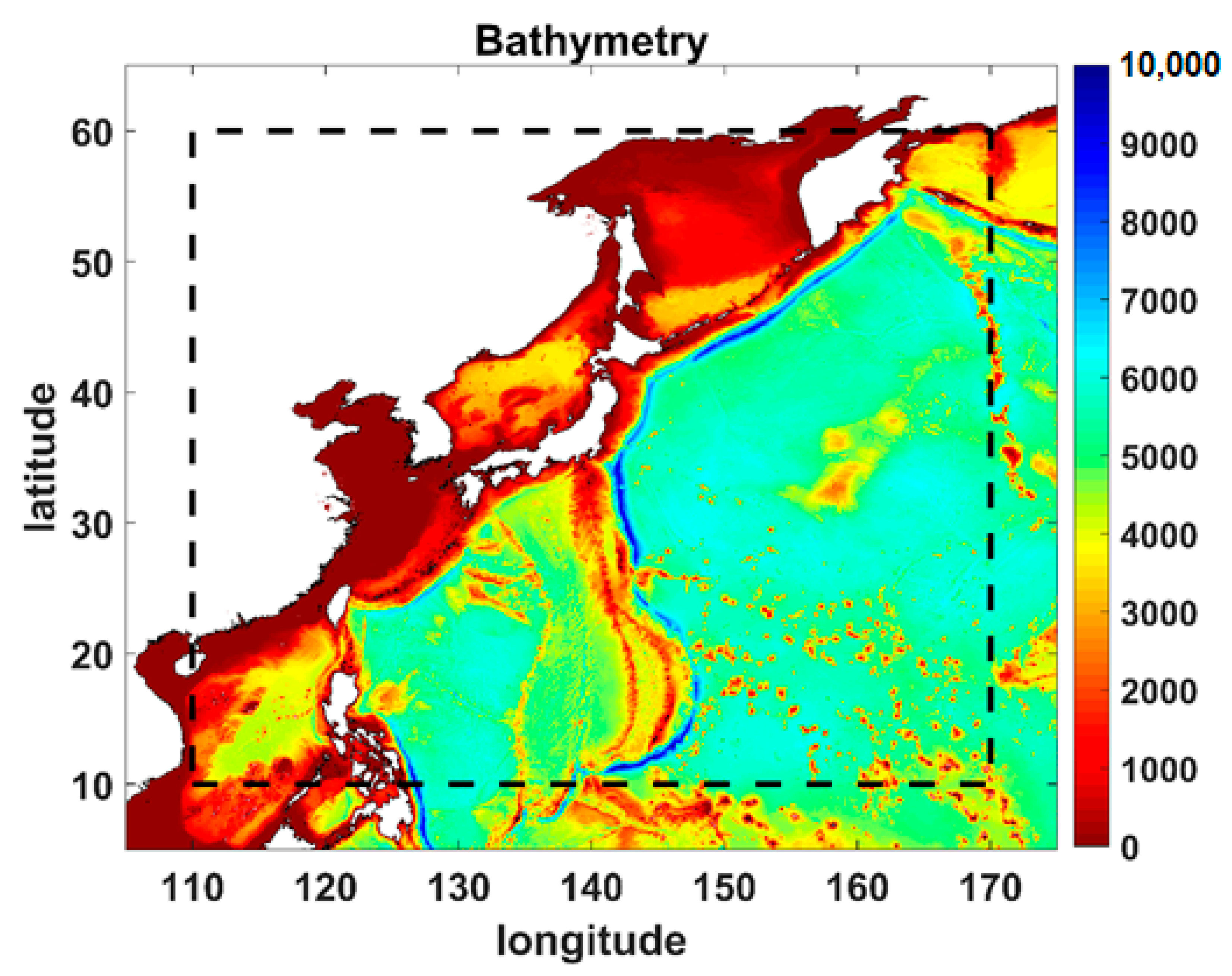
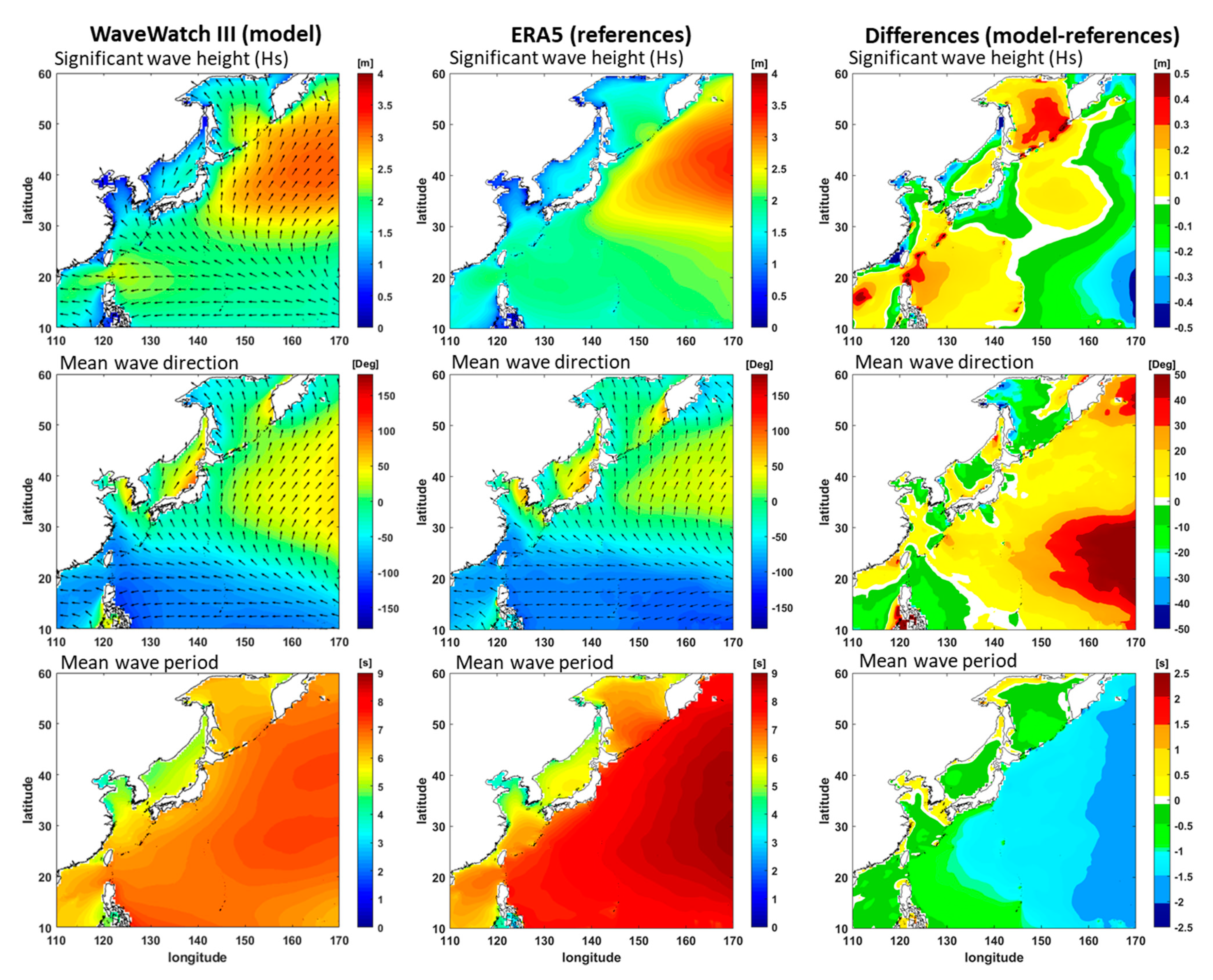
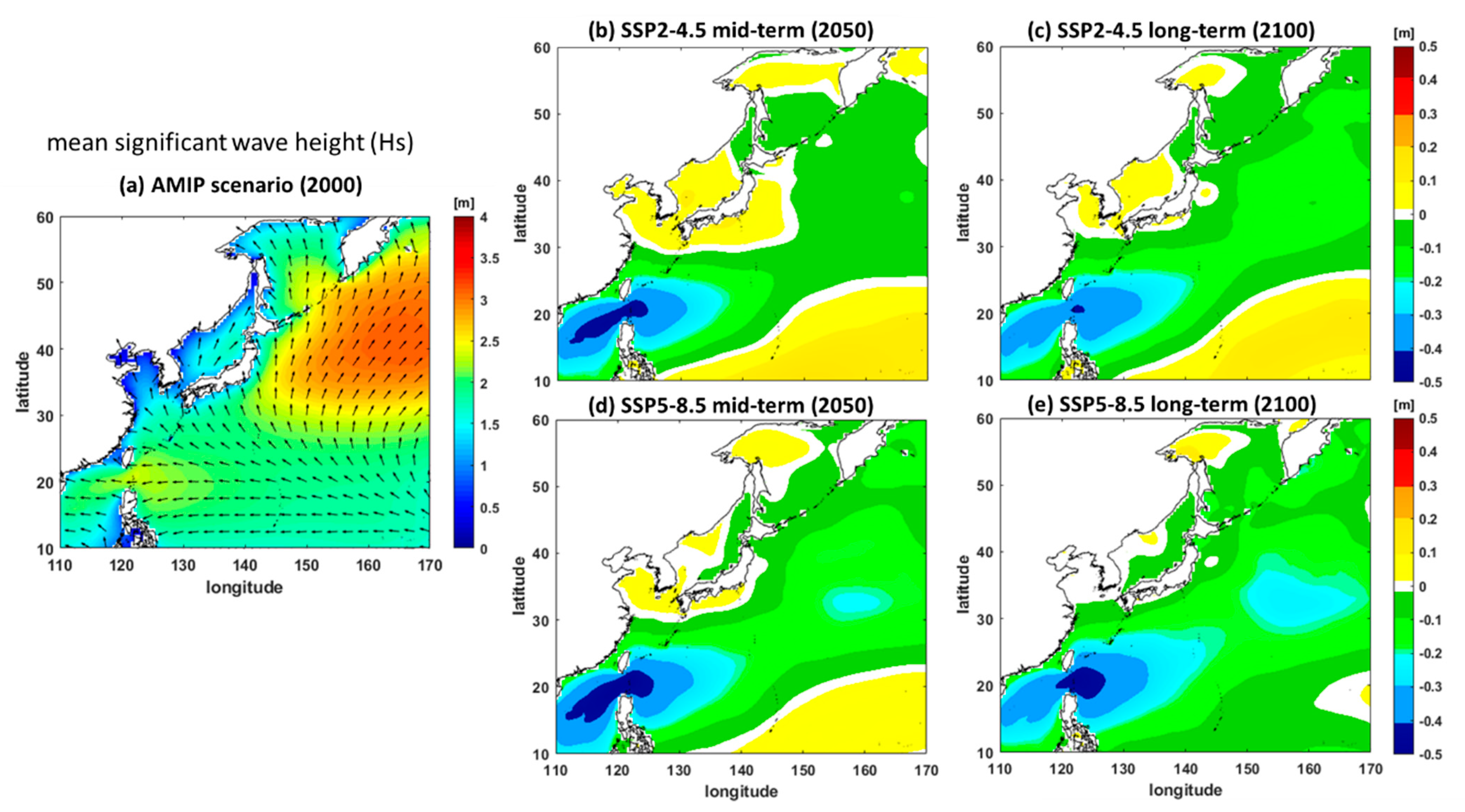
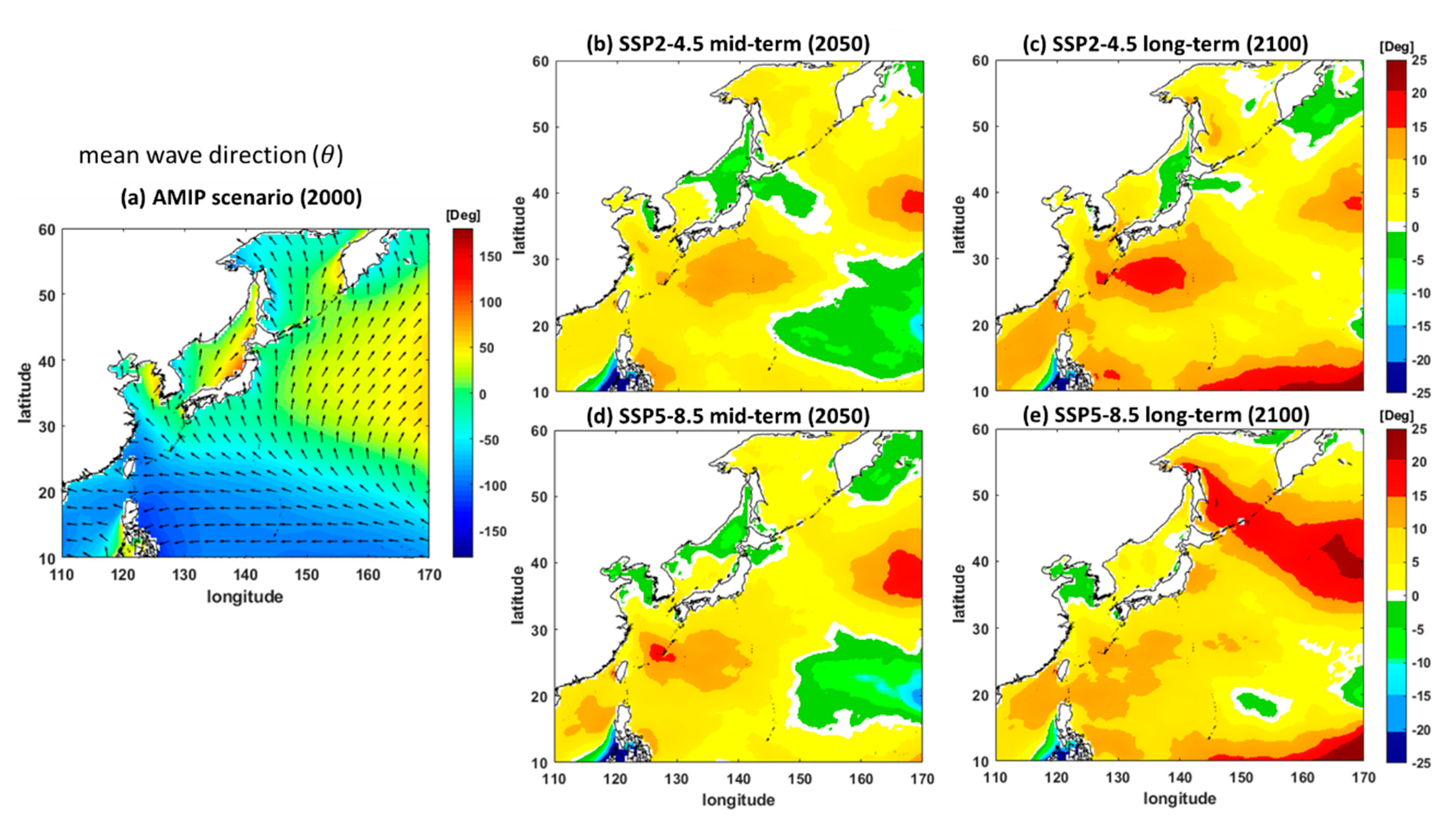
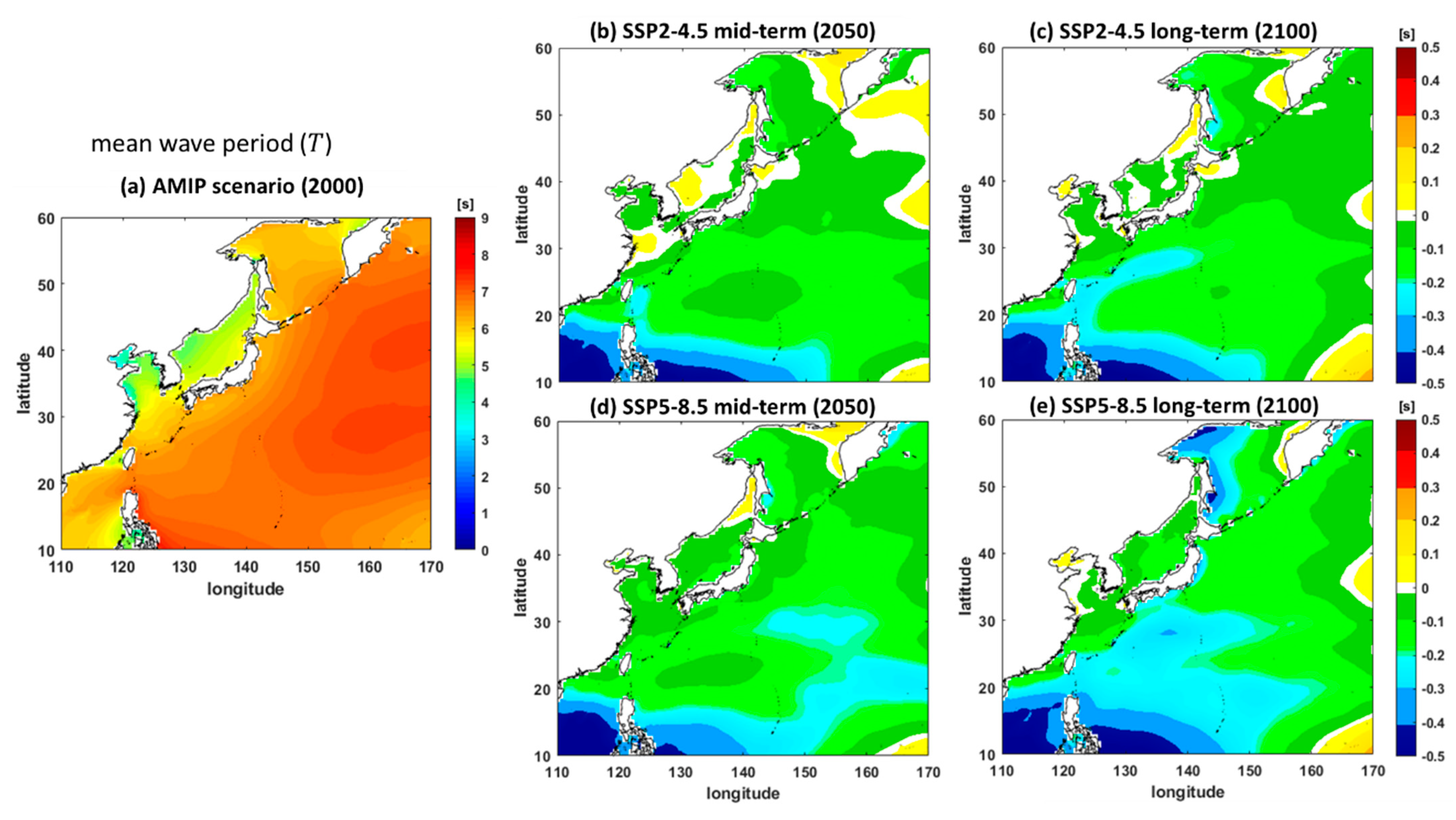
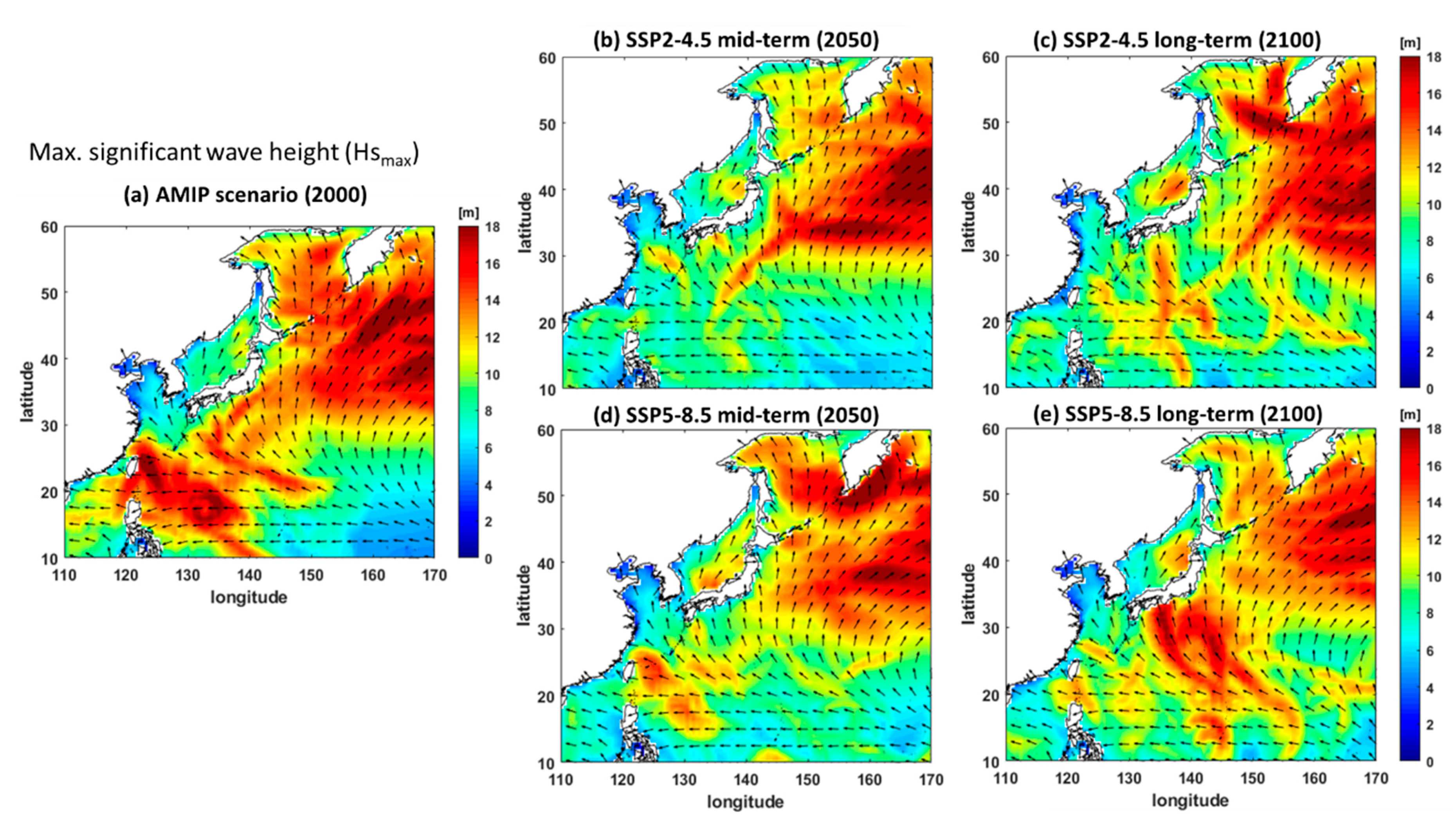
| Model | Spatial Resolution | Temporal Resolution | Ensemble |
|---|---|---|---|
| BCC-CSM2-MR | 1.12° × 1.125° | 3-h | r1i1p1f1 |
| IPSL-CM6A-LR | 1.267° × 2.5° | r1i1p1f1 | |
| MIROC6 | 1.4° × 1.40625° | r1i1p1f1 | |
| MPI-ESM1-2-HR | 0.9375° × 0.9375° | r1i1p1f1 | |
| MRI-ESM2-0 | 1.12° × 1.125° | r1i1p1f1 | |
| NESM3 | 1.865° × 1.875° | r1i1p1f1 | |
| CNRM-CM6-1 | 1.4° × 1.40625° | r1i1p1f2 | |
| CNRM-ESM2-1 | 1.4° × 1.40625° | r1i1p1f2 |
| Year | Scenario | Surface Wind (3 hourly) | WWIII Source Terms | Remarks | |||
| Wind Input (Sin) | Nonlinear Wave Interaction (Snl) | White Capping Dissipation (Sds) | Depth-induced Breaking (Sdb) | ||||
| 2000 | historical | AMIP | linear input (Cavaleri and Malanotte-Rizzli [41]) | discrete interaction approximation (DIA) | ST4 (Ardhuin et al. [45]) | (Battjes and Janssen [44]) | Bathymetry: GEBCO 15 arc-second data Shoreline: GSHHG |
| 2050 | SSP2-4.5 | 8 ensembles from 8 GCMs (Table 1) | |||||
| SSP5-8.5 | |||||||
| 2100 | SSP2-4.5 | ||||||
| SSP5-8.5 | |||||||
Publisher’s Note: MDPI stays neutral with regard to jurisdictional claims in published maps and institutional affiliations. |
© 2021 by the authors. Licensee MDPI, Basel, Switzerland. This article is an open access article distributed under the terms and conditions of the Creative Commons Attribution (CC BY) license (https://creativecommons.org/licenses/by/4.0/).
Share and Cite
Badriana, M.R.; Lee, H.S. Multimodel Ensemble Projections of Wave Climate in the Western North Pacific Using CMIP6 Marine Surface Winds. J. Mar. Sci. Eng. 2021, 9, 835. https://doi.org/10.3390/jmse9080835
Badriana MR, Lee HS. Multimodel Ensemble Projections of Wave Climate in the Western North Pacific Using CMIP6 Marine Surface Winds. Journal of Marine Science and Engineering. 2021; 9(8):835. https://doi.org/10.3390/jmse9080835
Chicago/Turabian StyleBadriana, Mochamad Riam, and Han Soo Lee. 2021. "Multimodel Ensemble Projections of Wave Climate in the Western North Pacific Using CMIP6 Marine Surface Winds" Journal of Marine Science and Engineering 9, no. 8: 835. https://doi.org/10.3390/jmse9080835







